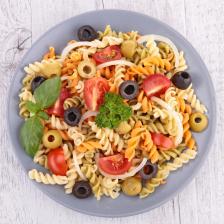Why Leftover Pasta Is Good for You
Whole wheat pasta is higher in fiber and easier on the blood sugar. But regular pasta just tastes better. Here’s a simple trick that lets you have it both ways.

In fact, with all the carb awareness these days, many people have given up pasta entirely.
See also: Carbs and Weight Gain
But some new research reveals an easy trick that actually reduces the amount of carbohydrates you absorb from pasta and also significantly curbs the impact on your blood sugar. Is pasta back on the menu?
Sponsor: Thanks to Audible for supporting our channel. Get a free audiobook of your choice at audiblepodcast.com/diva
What Is Resistant Starch?
The trick has to do with resistant starches, a special type of carbohydrate in which the molecules form bonds which make them resistant to digestion. In effect, a resistant starch acts more like fiber than starch. Foods that are high in resistant starch can help fill you up (and keep you full), which can help you to eat fewer calories.
See also: 3 Tips on How to Eat Less Without Feeling Hungry
I talked about resistant starches in a previous episode. Certain foods, such as green bananas and papayas, are rich in resistant starch. And, as I explained in that episode, cooking and then cooling starchy foods (think: pasta or potato salad) can also help convert some of the starch into a resistant form. But many of you wondered what would happen if you were to heat these foods up again? Would the resistant starch be converted back into regular starch?
At the time of that episode, this was still an open question. Researchers I consulted guessed (off the record) that at least some of the resistant starch in cooked and cooled foods would stay resistant when the foods were reheated. Not only do we now have a definitive answer to this question but the answer is even better than we hoped.
Why You Should Always Reheat Your Pasta
Dr. Denise Robertson of the University of Surrey in England, compared the effects of freshly cooked pasta, cooked and cooled pasta, and cooked, cooled, and reheated pasta on eaters’ blood sugar levels.
(The method they used to reheat the pasta, incidentally, is the method I recommend here.)
As expected, the cold pasta caused less of a rise in blood sugar than the freshly cooked pasta, due to the increase in resistant starch. But the difference was fairly modest. The real shocker was the reheated pasta: The rise in blood sugar after eating reheated pasta was 30-50% lower than the rise after eating freshly cooked pasta. In effect, the reheated white pasta acted in the body as if it were whole wheat pasta. But, of course, it still had the taste and texture of regular pasta.
Is Reheated Pasta Lower in Calories?
Reheated pasta still contains carbs and calories. The difference is that they are absorbed more slowly.
Now, a lot of people misinterpreted this research to mean that reheated pasta has 30-50% fewer calories. I’m afraid that’s not the case. The resistant starch created by cooling and reheating the pasta would reduce the calories in the pasta a bit. But as Dr. Robertson commented in an email to me, “I predict [the difference] wouldn’t be great.”
“The [press] put the spin on this being about calories,” she continued. “It isn’t really…it’s about reducing glycemic impact.”
In other words, reheated pasta still contains carbs and calories. The difference is that they are absorbed more slowly. This translates into steadier blood sugar as well as greater satiety, or appetite control. Ultimately, that could have a bigger impact on your weight than the relatively small difference in the calories.
And, as Dr. Robertson points out, “that’s before you start thinking of resistant starch as being a prebiotic.”
See also: What Are Prebiotics?
How to Use This Research

See also: Is Al Dente Pasta Healthier?
However, this new finding is not an excuse to eat larger servings of pasta. As I’ve pointed out before, when it comes to blood sugar, the size of the portion matters even more than whether you’re choosing refined or whole grain.
See also: The Truth About Whole Grains

Keep in Touch
Questions? Comments? Post them below or on the Nutrition Diva Facebook page, where there’s always a lively discussion going on about all aspects of food and nutrition.
Dry pasta and pasta salad images courtesy of Shutterstock.






